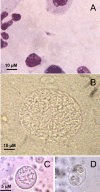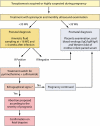Epidemiology of and diagnostic strategies for toxoplasmosis
- PMID: 22491772
- PMCID: PMC3346298
- DOI: 10.1128/CMR.05013-11
Epidemiology of and diagnostic strategies for toxoplasmosis
Erratum in
- Clin Microbiol Rev. 2012 Jul;25(3):583
Abstract
The apicomplexan parasite Toxoplasma gondii was discovered a little over 100 years ago, but knowledge of its biological life cycle and its medical importance has grown in the last 40 years. This obligate intracellular parasite was identified early as a pathogen responsible for congenital infection, but its clinical expression and the importance of reactivations of infections in immunocompromised patients were recognized later, in the era of organ transplantation and HIV infection. Recent knowledge of host cell-parasite interactions and of parasite virulence has brought new insights into the comprehension of the pathophysiology of infection. In this review, we focus on epidemiological and diagnostic aspects, putting them in perspective with current knowledge of parasite genotypes. In particular, we provide critical information on diagnostic methods according to the patient's background and discuss the implementation of screening tools for congenital toxoplasmosis according to health policies.
Figures








References
-
- Abbasi M, et al. 2003. Infection of placental trophoblasts by Toxoplasma gondii. J. Infect. Dis. 188:608–616 - PubMed
-
- Abgrall S, Rabaud C, Costagliola D. 2001. Incidence and risk factors for toxoplasmic encephalitis in human immunodeficiency virus-infected patients before and during the highly active antiretroviral therapy era. Clin. Infect. Dis. 33:1747–1755 - PubMed
-
- Afonso E, Thulliez P, Gilot-Fromont E. 2010. Local meteorological conditions, dynamics of seroconversion to Toxoplasma gondii in cats (Felis catus) and oocyst burden in a rural environment. Epidemiol. Infect. 138:1105–1113 - PubMed
-
- Afonso E, Thulliez P, Gilot-Fromont E. 2006. Transmission of Toxoplasma gondii in an urban population of domestic cats (Felis catus). Int. J. Parasitol. 36:1373–1382 - PubMed
-
- Afonso E, Thulliez P, Pontier D, Gilot-Fromont E. 2007. Toxoplasmosis in prey species and consequences for prevalence in feral cats: not all prey species are equal. Parasitology 134:1963–1971 - PubMed
Publication types
MeSH terms
LinkOut - more resources
Full Text Sources
Other Literature Sources
Medical

